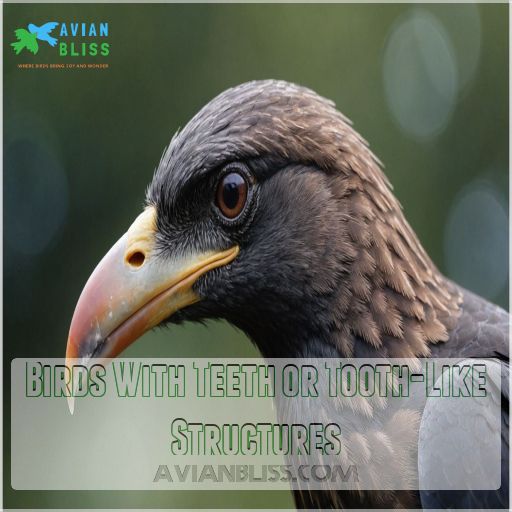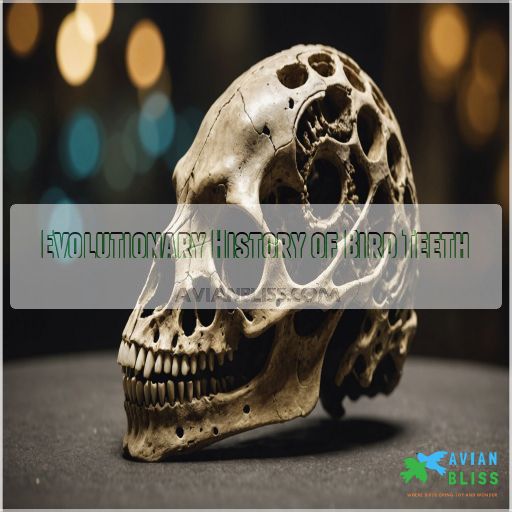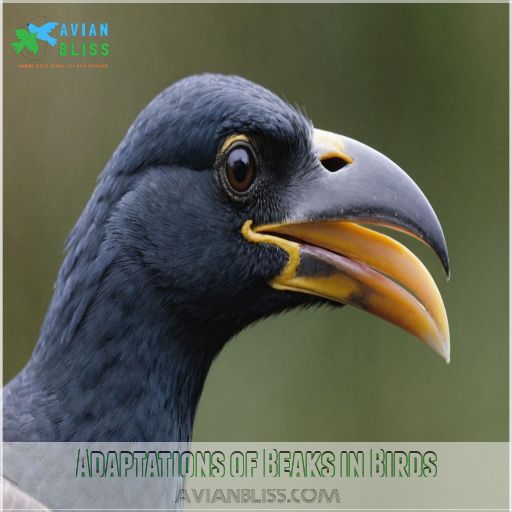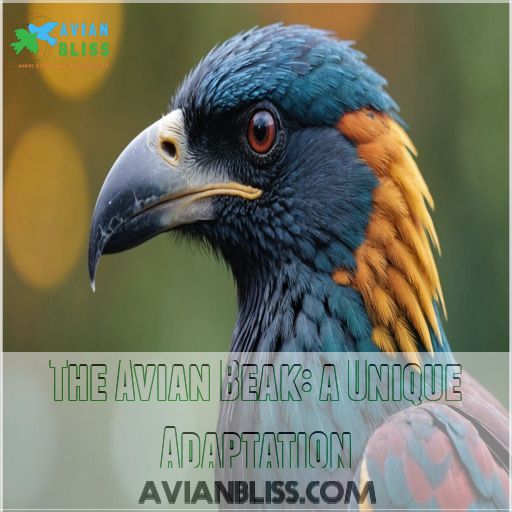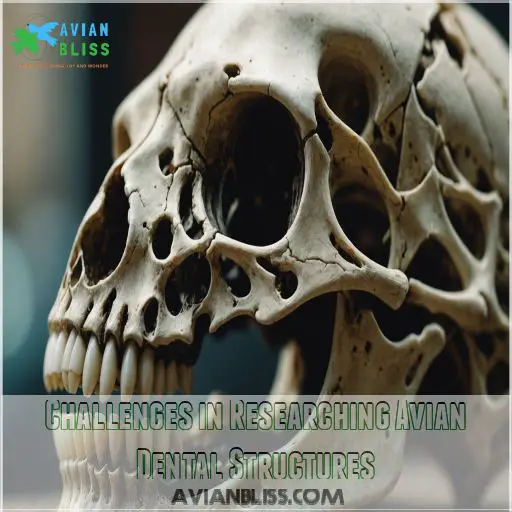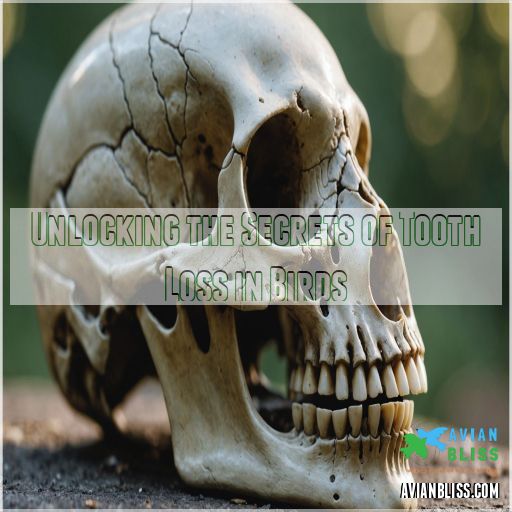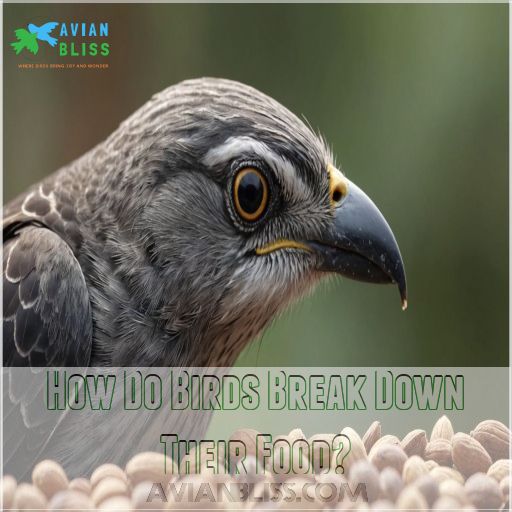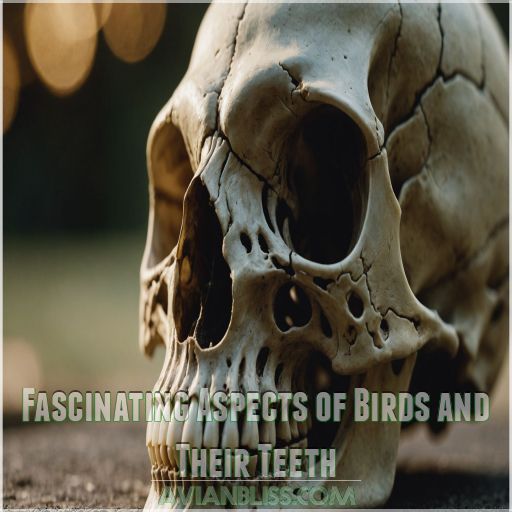This site is supported by our readers. We may earn a commission, at no cost to you, if you purchase through links.
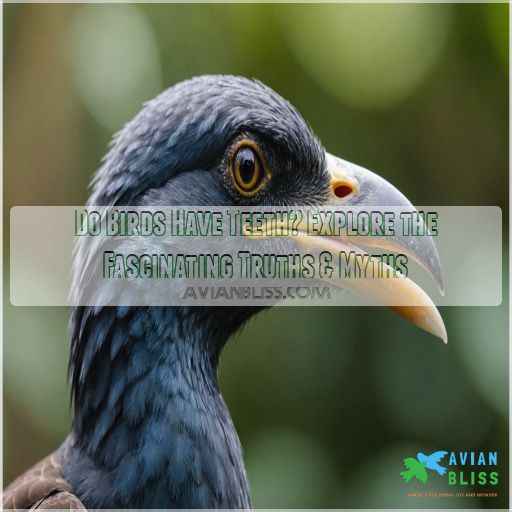
This toothless wonder is the result of millions of years of evolution. Birds’ ancestors, like the Archaeopteryx, had chompers, but today’s feathered friends rely on their versatile beaks for everything from cracking seeds to snatching fish.
Don’t feel bad for them though – beaks are lighter, perfect for flight, and develop faster in eggs. Plus, birds have a secret weapon: a muscular gizzard that grinds up food like nature’s own food processor.
There’s more to this toothless tale than meets the eye.
Table Of Contents
- Key Takeaways
- Birds With Teeth or Tooth-Like Structures
- Evolutionary History of Bird Teeth
- Why Do Modern Birds Lack Teeth?
- Adaptations of Beaks in Birds
- The Avian Beak: a Unique Adaptation
- Challenges in Researching Avian Dental Structures
- Unlocking the Secrets of Tooth Loss in Birds
- The Significance of Studying Birds With Teeth
- How Do Birds Break Down Their Food?
- Fascinating Aspects of Birds and Their Teeth
- Frequently Asked Questions (FAQs)
- Do chickens have teeth?
- Why do birds have no teeth?
- Why do birds have beaks instead of teeth?
- Do birds have teeth?
- What was the last bird to have teeth?
- Why do birds not have teeth?
- How do birds chew without teeth?
- What is the teeth bird called?
- How do birds swallow and digest without teeth?
- Can birds regrow lost or damaged beak parts?
- Do any birds have tooth-like structures inside their beaks?
- How do different beak shapes affect bird diets?
- Whats the impact of beak health on bird survival?
- Conclusion
Key Takeaways
- You won’t find pearly whites in a bird’s mouth—they’ve traded teeth for beaks over millions of years of evolution. It’s nature’s way of saying, "Who needs a toothbrush when you’ve got a multipurpose tool on your face?"
- Birds’ beaks are like Swiss Army knives, adapted for everything from cracking nuts to sipping nectar. Each species has its own specialized beak shape, proving that one size doesn’t fit all in the avian world.
- Don’t feel bad for our toothless feathered friends—they’ve got a built-in food processor called a gizzard. It’s like having a tiny rock tumbler in their belly, grinding up food without the need for chompers.
- While most modern birds are toothless wonders, some species still sport tooth-like structures. It’s nature’s way of keeping us on our toes and reminding us that evolution always has a few tricks up its sleeve.
Birds With Teeth or Tooth-Like Structures
You might be surprised to learn that some birds do have teeth-like structures!
Geese, penguins, and even the quirky tooth-billed bowerbird all possess unique dental adaptations that help them thrive in their environments.
Bird Species With Dental Structures
If you’ve ever wondered, "Do birds have teeth?" you’re not alone. Although birds have evolved fascinating structures resembling teeth, they’re not true teeth.
For example:
- Tooth-billed pigeons sport serrated edges for seed-crushing.
- Geese groove their beaks with tomia, aiding feeding.
- Penguins’ papillae line their beaks, gripping slippery prey.
These adaptations highlight birds’ evolutionary advantage and beak mastery.
Functions of Teeth in Birds
Think of a bird’s beak as a Swiss army knife, evolved from toothy ancestors to tackle diverse dietary challenges.
A few ancient birds had teeth or tooth-like structures, helping them grip and process food.
These features reflected feeding adaptations and evolutionary shifts from teeth to beaks, showcasing nature’s creative solutions for survival.
Examples of Birds With Teeth or Tooth-Like Structures
Considering their functions, let’s explore some intriguing avian dental adaptations.
The Tooth-billed bowerbird doesn’t actually have teeth but uses a specialized bill to process food.
Penguins have papillae on their tongues, resembling tiny teeth, aiding in gripping slippery prey.
Goose tomia features serrated edges that look tooth-like, showcasing avian biodiversity’s knack for dental improvisation.
Evolutionary History of Bird Teeth
You might be surprised to learn that birds’ ancestors, the dinosaurs, actually had teeth.
But don’t worry, modern birds have evolved a much more efficient tool – their beaks.
Let’s take a closer look at the fascinating evolutionary history of bird teeth and how they’ve adapted over time.
Ancient Birds With Teeth
Picture the Jurassic period, when birds like Archaeopteryx flaunted tiny teeth. These ancient teeth were essential for their survival and were shaped by evolutionary pressures. Fossil evidence reveals information about their role in ancient bird diets.
- Tooth function was diverse.
- Teeth supported varied diets.
- Fossils reveal bird history.
- Evolution shifted priorities.
The Transition From Teeth to Beaks
How did birds swap their chompers for beaks? It’s a tale of evolution that’ll knock your socks off!
Fossil evidence shows this change wasn’t an overnight affair. About 100 million years ago, you’d have seen birds like Ichthyornis sporting both a pincer-like beak and teeth.
This combo gave them a unique edge, crunching fish with dinosaur-like jaws while using their beak for precision picking. Talk about having your cake and eating it too!
The Genetic Basis of Tooth Loss in Birds
Want to know the secret behind why birds lost their teeth? It’s a story that goes back over 100 million years!
Turns out, gene mutations in tooth-related proteins like AMELX and ENAM played a key role in this toothy tale .
As beaks evolved, birds said goodbye to their dinosaur grins. It’s like nature decided birds needed a dental makeover for their airborne adventures!
Why Do Modern Birds Lack Teeth?
You might be surprised to learn that modern birds don’t have teeth, but their ancestors did.
This toothless trait has puzzled scientists for years, leading to fascinating discoveries about how diet, environment, and evolution have shaped the beaks we see in birds today.
Advantages and Disadvantages of Beaks
As ancient birds bid farewell to their toothy grins, they gained a powerful tool: the beak. This evolutionary trade-off brought both perks and quirks.
You’d think losing teeth would be a bummer, but beaks proved to be nature’s Swiss Army knife for our feathered friends. This adaptation is largely attributed to the significant advantage it provided because of reduced weight for flight efficiency. It’s also worth noting that the development of beaks allowed for faster embryo development, leading to quicker hatching times.
- Lightweight design for flight
- Built-in multipurpose tool (cracking seeds to snatching fish)
- No cavities or dental bills
- Self-sharpening tools, preening, nest-building)
- Self-sharpening Customizable shapes for diverse diets (sorry, no one-size-fits-all here!)
The Role of Diet in Shaping Avian Evolution
Ever wondered why your feathered friends don’t flash a toothy grin?
It’s not just about looking cute! Dietary specialization has played a starring role in shaping avian evolution.
As birds adapted to different food sources, their beaks evolved into a Swiss Army knife of diversity .
From cracking nuts to sipping nectar, these versatile tools became nature’s way of saying, "Who needs teeth when you’ve got a beak?"
The Impact of Environment on Beak Development
You’ve seen how diet shapes bird evolution, but let’s talk beaks.
These nifty tools are nature’s Swiss Army knives, adapting to environmental pressures like nobody’s business. Think of it as evolution’s makeover show – habitat influence and adaptive evolution work their magic on beak shape.
From cracking meat to tearing meat, each beak tells a story of survival (Source). It’s like birds got a memo: "Teeth are so last eon!
Adaptations of Beaks in Birds
You’ll be amazed at how birds’ beaks have evolved to tackle every feeding challenge nature throws their way.
From the toucan’s fruit-peeling prowess to the woodpecker’s tree-drilling expertise, these specialized tools are a clear example of nature’s ingenuity in crafting the perfect utensil for every avian meal.
Beak Shape, Color, and Function
Three cheers for beaks! These marvels of bird morphology come in a dazzling array of shapes and colors.
From the falcon’s tomial tooth for swift kills to the snail kite’s long, narrow tip for shell-cracking, beaks are nature’s Swiss Army knives.
They’re not just for eating either – birds use them to preen, court mates, and even fly better. Talk about functional diversity!
It’s like evolution crafted a unique multitool for each species.
The Importance of Beaks in Feeding
While a bird’s beak shape and color catch your eye, it’s the beak’s feeding function that’ll blow your mind.
Beaks are nature’s Swiss Army knives, each uniquely designed for dining.
From seed-cracking conical beaks to fish-spearing daggers, these tools are a bird’s ticket to survival .
It’s like they’ve got built-in utensils – who needs a knife and fork when you’ve got a beak that does it all?
Beak Adaptations for Different Environments
Birds’ beaks are like Swiss Army knives, each adapted for a unique environment.
Ever seen a flamingo’s comma-shaped bill? It’s perfect for filter-feeding in muddy waters (Source).
Hummingbirds sport needle-like beaks to sip nectar from flowers, while toucans flaunt multifunctional beaks for everything from fruit-picking to cooling off.
Even the crossbill’s oddly-shaped beak is a clever tool for prying open pine cones.
Nature’s ingenuity at its finest!
The Avian Beak: a Unique Adaptation
You’ve probably noticed birds don’t smile with pearly whites, and that’s because they’ve traded teeth for beaks.
These versatile tools come in a dizzying array of shapes and sizes, each perfectly adapted to help birds crack nuts, snag fish, or sip nectar with impressive efficiency.
The Diversity of Beak Shapes and Functions
Peering into the avian world, you’ll find a smorgasbord of beak shapes and sizes, each perfectly suited for a specific feeding strategy.
From the cone-shaped beaks of finches, perfect for cracking seeds , to the dagger-like bills of kingfishers for impaling fish , evolution has crafted an impressive array of tools.
You’ll spot hummingbirds sipping nectar with their straw-like beaks, while toucans use their oversized schnozzes as built-in air conditioners. It’s like nature’s Swiss Army knife – there’s a beak for every job!
This diversity showcases the remarkable adaptations birds have developed to thrive in various environments, highlighting their incredible ability to evolve.
The Genetic Basis of Beak Development
Every bird’s beak tells a unique genetic story. You’d be amazed at how a handful of genes can shape such diverse beaks! Take the ALX1 gene, for instance.
It’s like the master sculptor of bird faces, influencing everything from blunt to pointed beaks . Imagine Darwin’s finches as nature’s own genetic experiment.
Over time, evolutionary pressures have tweaked genes like CALM and FGF10, resulting in a smorgasbord of beak shapes (Source). It’s as if Mother Nature’s playing mix-and-match with DNA, creating beaks perfect for cracking seeds or sipping nectar.
Isn’t evolution a hoot? It’s also as if Mother Nature is playing mix-and-match with DNA.
Challenges in Researching Avian Dental Structures
You might think studying bird teeth would be a breeze, but it’s actually a tricky business.
With so few birds sporting chompers these days, scientists have to get creative to unravel the mysteries of avian dental structures.
Rarity of Birds With Teeth
The quest to find birds with teeth is like searching for a needle in a haystack. You’d have better luck spotting a unicorn! Modern birds have evolved beaks, ditching their toothy ancestors. This rarity poses quite the challenge for researchers studying avian dental structures.
- Extinct birds hold the key to dental secrets
- Genetic basis of tooth loss is a puzzle to solve
- Beak evolution has left few toothy clues behind
Complexity of Studying Dental Development
Studying dental development in birds is a real head-scratcher! Genetic mutations and evolutionary pressures have left modern birds toothless, making research a real head-scratcher.
Fossil evidence is scarce, and comparative anatomy with toothed ancestors is challenging. But don’t ruffle your feathers – scientists are pecking away at the mystery.
Check out this table of hurdles they face:
| Challenge | Impact | Solution Approach |
|---|---|---|
| Rare fossils | Limited data | Advanced imaging |
| Gene silencing | Unclear tooth loss | Genomic analysis |
| Beak adaptations | Obscured evidence | 3D modeling |
Overcoming Challenges in Avian Dental Research
Studying bird teeth is like trying to find a needle in a haystack – with the haystack being millions of years old!
You’ve got to roll up your sleeves and dig into genetic analysis, fossil records, and comparative anatomy. It’s a real head-scratcher, but scientists are cracking the case.
They’re using biomechanics to understand how ancient bird teeth worked and piecing together evolutionary puzzles. Talk about a toothy challenge!
Unlocking the Secrets of Tooth Loss in Birds
You might wonder why birds don’t flash toothy grins like crocodiles.
Scientists have cracked open this mystery by studying bird genomes, uncovering the genetic switches that turned off tooth growth millions of years ago.
Analyzing Bird Genomes for Dental Genes
Genetic sleuthing has cracked a toothy mystery! You’re about to take a journey through bird genomes, where ancient dental secrets lie hidden. Scientists have become DNA detectives, piecing together evolutionary puzzles.
Let’s explore how they’re cracking the code of avian tooth loss:
- Combing through genomes for dental gene ghosts
- Comparing bird genomes to their toothed ancestors
- Unraveling beak development pathways
- Decoding nature’s dental plan gone awry
It’s like finding fossilized footprints in a bird’s genetic code – fascinating and slightly mind-boggling!
Identifying Mutations Leading to Tooth Loss
You’ve cracked the code of bird tooth loss! Scientists have unearthed shared mutations in genes responsible for tooth formation across 48 bird species . These genetic hiccups have turned birds’ choppers into ancient history.
Let’s take a peek at some key players in this toothy tale:
| Gene | Function |
|---|---|
| DSPP | Dentin formation |
| ENAM | Enamel production |
| AMELX | Enamel matrix |
| MMP20 | Enamel maturation |
Talk about a mouthful! These mutations are like nature’s dental plan, trading teeth for beaks in our feathered friends.
The Timeline of Tooth Loss in Birds
Those genetic mutations we discovered? They’re just the tip of the iceberg! Let’s take a wild ride through time and uncover the jaw-dropping timeline of bird tooth loss. It’s like piecing together a 150-million-year-old puzzle, with each fossil telling a toothy tale.
The gizzard, nature’s grinder, played a significant role in this change, allowing birds to thrive in various ecological niches the gizzard’s mechanical breakdown. Amazingly, scientists found that all living birds lost their enamel-covered teeth around 116 million years ago. This loss was a result of genetic mutations that blocked tooth development, a process that took up to 60% of the incubation period in bird embryos.
Talk about a dental revolution!
- Archaeopteryx: The rebel with a mouthful of teeth
- Hesperornis: The diving bird hanging onto its chompers
- Modern birds: Embracing their toothless freedom
The Significance of Studying Birds With Teeth
You’ll be amazed at how studying birds with tooth loss evolution can reveal secrets of avian evolution and beak development
.
By examining these rare dental structures, scientists are piecing together the puzzle of how modern birds lost their chompers and gained their versatile beaks.
Insights Into Avian Evolution
Ever wondered why we don’t see birds chomping with pearly whites? Studying ancient birds with teeth offers a window into avian evolution.
Fossil evidence reveals how our feathered friends moved from toothed jaws to diverse beaks.
This shift, linked to their dinosaur lineage, sheds light on evolutionary pressures and flight adaptations.
It’s like nature’s great dental plan – trading chompers for beaks to soar through the skies, all part of nature’s great dental plan.
Understanding the Adaptive Advantages of Beaks
Nature’s grand design has given birds a real leg up with their beaks. As we’ve seen, avian evolution’s dropped the toothy grin for something far more versatile.
Let’s crack open beak adaptations:
- Beak diversity spans from seed-cracking cardinals to meat-tearing raptors
- Beak evolution fine-tunes shape and size for specific diets
- Beak mechanics allow for filter-feeding flamingos and insect-hunting woodpeckers
Talk about a Swiss Army knife for the face! These adaptations are the birds’ secret sauce for survival.
Implications for Conservation and Research
Beaks are cool, but birds with teeth? That’s where the real adventure begins!
You’d be surprised how studying these toothy wonders can revolutionize bird conservation. By unraveling the genetic mysteries behind beak evolution, scientists are uncovering secrets that could help protect endangered species.
It’s like CSI for birds – using dental research to crack the case of avian diversity. Who knew teeth could be such powerful tools for feathered freedom?
How Do Birds Break Down Their Food?
Ever wondered how birds manage to chow down without chompers? Let’s uncover the clever ways our feathered friends break down their food, from powerful beaks to built-in grinding stones.
The Role of Beaks in Feeding
You’ve heard the saying "bite off more than you can chew," but for birds, it’s all about the beak. These feathered friends break down their food in a fascinatingly efficient way.
- Beak shape: Evolved for specific diets
- Feeding adaptations: Specialized notches for gripping prey
- Prey capture: Tomial "tooth" for quick, humane kills
- Beak evolution: Replaced teeth for lighter, flight-friendly skulls
Talk about a bird’s-eye view of dining!
The Importance of Gizzard Stones
Ingenuity lies at the heart of avian digestion.
Without teeth, birds rely on gizzard stones, also known as durable gastroliths, to grind their food
.
These tiny rocks, swallowed intentionally, act like nature’s own food processor inside the muscular gizzard.
You’ll find birds pecking at gravel, not for a snack, but to stock up on these digestive helpers .
It’s like they’ve got a built-in mortar and pestle!
Enzymatic Digestion in Birds
While gizzard stones are nature’s grinders, birds have another trick up their feathers: enzymatic digestion. It’s like having a tiny chemistry lab in their gut!
- Proventriculus power: This glandular stomach secretes hydrochloric acid and pepsin to start the digestive party.
- Gizzard grinding: Food meets mechanical might, prepping it for enzyme action.
- Intestinal magic: Specialized enzymes work their molecular mojo, turning food into fuel.
Fascinating Aspects of Birds and Their Teeth
You might think birds don’t have teeth, but some species surprise us with tooth-like structures that help them chomp and chew.
From the tiny tomia in goose beaks to the spiky papillae inside penguin bills, these fascinating features showcase nature’s clever adaptations for different diets and lifestyles.
Interesting Facts About Birds With Teeth
Birds mightn’t flash pearly whites, but they’ve got some toothy secrets up their feathered sleeves.
Did you know that baby birds sport a tiny tooth to crack open their eggs? It’s nature’s built-in egg opener.
And get this – the hoatzin, a quirky South American bird, actually hatches with a tooth and then ditches it faster than you can say "beak-a-boo!
The Evolution of Bird Teeth
You might think birds never had teeth, but hold onto your hats! The evolution of bird teeth is a wild ride through time, and the ostrich’s unique eating habits offer a fascinating glimpse into this adaptation
. Let’s take a trip down memory lane to when our feathered friends were more like toothy terrors.
- Archaeopteryx, the OG bird, sported a full set of chompers
- Around 116 million years ago, genetic mutations kicked off tooth loss
- Beak evolution started at the front, moving back like a reverse mullet
- Some early birds, like Ichthyornis, rocked both beaks and teeth
- Modern birds still have dormant tooth genes – talk about ancestral baggage!
Unique Dental Structures in Birds
Ever wondered about the toothy grins of our feathered friends? Take a gander at the unique dental structures in birds.
Evolution’s crafty handiwork has given some species papillae and serrated tomia – nature’s answer to teeth.
The bowerbird, for instance, sports these nifty adaptations. It’s like they’ve got built-in Swiss Army knives for beaks!
These structures help birds tackle tough foods, making meal a breeze in the avian world.
Frequently Asked Questions (FAQs)
Do chickens have teeth?
Chickens don’t have traditional chompers, but nature’s got a trick up its sleeve.
These feathered friends use tiny rocks in their gizzards to grind food, a clever workaround for their toothless beaks.
It’s nature’s built-in food processor!
Why do birds have no teeth?
Birds ditched their chompers to speed up egg hatching. It’s not about being lightweight or beak superiority.
Tooth development gobbles up 60% of incubation time.
Toothless beaks let chicks crack out faster, giving them a head start in life.
Why do birds have beaks instead of teeth?
Did you know teeth take up 60% of egg incubation time?
That’s why birds evolved beaks.
They’re nature’s fast-food solution, allowing quicker hatching and giving chicks a head start in life’s race.
Talk about efficiency!
Do birds have teeth?
You won’t find pearly whites in a bird’s beak!
Modern birds lack teeth, instead relying on beaks and muscular gizzards to process food.
This toothless adaptation likely made them lighter for flight and quicker to hatch.
What was the last bird to have teeth?
The last bird with true teeth vanished during the mass extinction 66 million years ago.
However, some extinct pelagic birds, like Pelagornis, sported bony projections resembling teeth until about 5 million years ago, a quirk of avian evolution .
Why do birds not have teeth?
Birds evolved without teeth to speed up egg hatching.
This toothless adaptation reduced incubation time from months to days, giving chicks a survival edge.
It’s nature’s way of saying, "Time to spread your wings faster!
How do birds chew without teeth?
Did you know a bird’s gizzard can crush shells with 300 times more force than human jaws?
Nature’s clever workaround: birds swallow food whole, then their muscular gizzard grinds it up using small stones.
It is a built-in food processor!
What is the teeth bird called?
Imagine a prehistoric bird with a toothy grin!
Pelegornathids, or "bony-tooth birds," sported jaw projections that looked like teeth but weren’t.
These extinct giants ruled the skies for 60 million years, leaving fossils worldwide.
How do birds swallow and digest without teeth?
Ever wondered how our feathered friends gulp down grub without chompers? You’d be amazed!
They swallow whole, letting their muscular gizzard do the heavy lifting.
It’s nature’s food processor, grinding meals with tiny stones for perfect digestion. Talk about gut instinct!
Can birds regrow lost or damaged beak parts?
Birds’ beaks are like nature’s Swiss Army knives, constantly growing and repairing themselves.
You’ll be amazed to learn that most beak damage can heal, just like your fingernails.
It’s a slow process, but these resilient creatures often bounce back.
Do any birds have tooth-like structures inside their beaks?
While birds don’t have true teeth, some sport tooth-like structures inside their beaks.
You’ll find lamellae in ducks and geese, acting like tiny combs for filter-feeding.
It’s nature’s way of giving birds a helping hand – or beak!
How do different beak shapes affect bird diets?
Surprisingly, beak shape accounts for only 12% of birds’ dietary variation.
You’ll find hummingbirds sipping nectar with needle-like bills, finches cracking seeds with conical beaks, and flamingos filter-feeding with upside-down bills.
Nature’s culinary toolkit is truly remarkable!
Whats the impact of beak health on bird survival?
Healthy beaks are absolutely essential for bird survival.
They’re essential for foraging, preening, and breeding.
Deformities can lead to malnutrition, hypothermia, and increased predation risk.
Even slight irregularities might impact a bird’s ability to thrive in the wild, leading to issues like malnutrition.
Conclusion
Ironically, the question "do birds have teeth?" leads us to a toothless truth. Modern birds have swapped dental hardware for beaks, a trade-off that’s served them well.
From cracking nuts to catching fish, beaks are nature’s Swiss Army knife. While a few oddball species still sport tooth-like structures, most birds rely on their versatile beaks and muscular gizzards.
So next time you spot a bird, remember – behind that toothless grin lies millions of years of clever adaptations. Who needs teeth when you’ve got a multipurpose beak?

